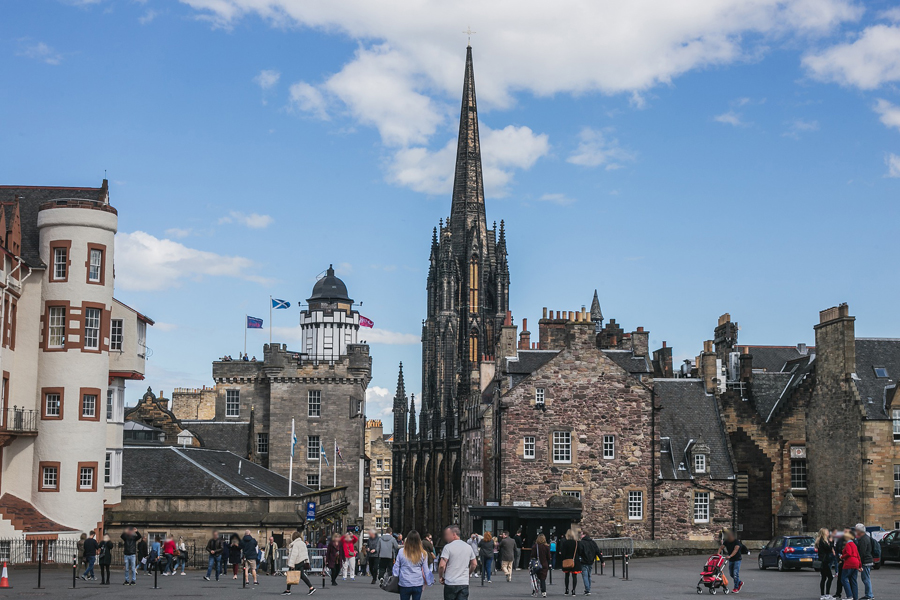The Royal Mile is a series of streets in the center of Old Town of the city of Edinburgh in Scotland, United Kingdom.
In total, the length of the road is approximately one Scottish mile – 1.8 km, it is about 200 m longer than the British one.The famous street in Edinburgh It begins at Edinburgh Castle and leads to Holyrood Bridge. Also small streets that diverge from the main one in different directions belong to a mile.
The Royal Mile began to appear in the 12th century. Once an open market appeared at the foot of the castle, then wooden houses and yards for cattle breeding began to be erected. After 4 centuries, the British burned them down and built new houses of stone.
In the middle of the 17th century. The old town became too overpopulated about 70 thousand people lived along the street. The problem was also that sometimes about 10 people could share one room, in buildings that could be up to 14 stories high. In the XVIII century. they decided to expand the city. With the construction of the New City, the problem of overpopulation was solved by itself. From 1865, Blackfriars Street and St. Maris Street were built by Lord William Chambers. In the 1880s. the biologist Patrick Geddes continued the construction of houses, courtyards and gardens were built according to plans that repeated the Royal Mile 500 years ago.
The Royal Mile is also known as the High Street by locals, the name of one of its streets, the other streets are: Castle Esplanade, Castlehill, Lawnmarket, Canongate and Abbey Strand. Along with Princes Street in New Town.Today the Royal Mile is undoubtedly the busiest tourist street in Edinburgh.It also serves as the heart of Scotland’s Legal System, being the home of the Supreme Court of Justice and the Court of Session.
Access : Coordinates: 55.950556, -3.185556 / Location : Old Town of the city of Edinburgh in Scotland.
Highlights :
- Castlehill : The Royal Mile begins with the Castle Esplanade at Edinburgh Castle, which was laid out in the 19th century for military parades. It hosts the Royal Edinburgh Military Band Parade every year.
- Lonemarket was formerly a market for linen. The street is now home to small tourist-oriented souvenir shops, primarily selling kilts and other Scottish wool products.
- High street : During the many Edinburgh festivals, the street becomes the center of public life in the city, where tourists, street musicians, festival participants and visitors flock.On the left is the Supreme Court building, on the right, right on Parliament Square, is the building of the old Parliament of Scotland, as well as St. Giles Cathedral, which is the center of Scottish Presbyterianism.The street is crossed by bridges – the North Bridge and the South Bridge. Also on the High Street, it is worth visiting the Museum of Childhood and the House-Museum of the religious reformer John Knox.
- Canongate : The name Canongate comes from canon’s gait (“monastic street”), in honor of the Augustinians of Holyrood Abbey. This street is home to the Morey House, Faculty of Education, University of Edinburgh; Canongate Tolbooth – a former prison and court, now the Edinburgh Folk History Museum; Edinburgh Museum. The Canongate Church, built in the Dutch colonial style, looks unusual for the buildings of the Church of Scotland.
- the scary Mary Kings area on the Royal Mile. There are more ghosts here than in the rest of the UK. About 300 years ago, a plague epidemic raged in the city. To stop its spread, the authorities decided to block the entrance to the area with bricks. Hundreds of people died without waiting for help.
- Statues of world-renowned Scots such as David Hume and Adam Smith are part of those who walk the route.
Go next : Edinburgh Castle / Royal Palace : Holyroodhouse Palace. / Dean Village , located near the Stockbridge neighborhood of Edinburgh.

